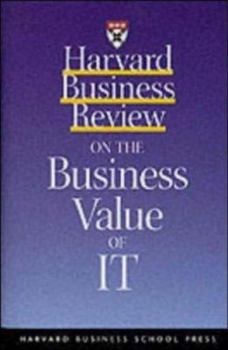Harvard Business Review on the Business Value of It (Harvard Business Review Paperback Series)
Information technology (IT) influences all aspects of business, this resource aims to help managers understand the concepts and terms, and envision the potential of their IT assets. It looks at the issues surrounding outsourcing, and at the planning for connectivity and control in the year 2000.
Format:Paperback
Language:English
ISBN:0875849121
ISBN13:9780875849126
Release Date:February 1999
Publisher:Harvard Business Review Press
Length:239 Pages
Weight:0.75 lbs.
Dimensions:8.8" x 0.8" x 5.5"
Customer Reviews
3 ratings
Dated applications but the core concepts are still relevant
Published by Thriftbooks.com User , 19 years ago
Much of the contextual material in this volume is out-of-date, given the fact that the articles originally appeared in the Harvard Business Review years ago (1993-1998). However, I think the core concepts remain sound and, if anything, are even more relevant now. In this volume, the reader is provided with eight brilliant analyses of how to obtain much greater value from IT. No brief commentary such as this can do full justice to the rigor and substance of these articles. It remains for each reader to examine the list to identify those subjects of greatest interest to her or him. My own opinion is that all of the articles are first-rate. One of this volume's greatest benefits is derived from sharing a variety of perspectives provided by a number of different authorities on the same general subject. Readers will especially appreciate the provision of an executive summary which precedes each article. They facilitate, indeed expedite frequent review of key points which - presumably - careful readers either underline or highlight. Also of interest is the "About the Contributors" section which includes suggestions of other sources to consult.. Here are questions which suggest key issues to which their authors respond: How to establish and then develop "human centered information management"? (Thomas H. Davenport) How can outsourcing help to maximize flexibility and control if IT (Mary C. Lacity, Leslie P. Willcocks, and David F. Feeny) What is British Petroleum's competitive approach to outsourcing and what lessons can be learned from its initiatives? (John Cross) How and why did Continental Bank outsource its "crown jewels"? (Richard L. Huber) How can "managing by wire" help organizations to identify and then respond to rapidly changing customer needs? (Stephan H. Haeckel and Richard L. Nolan) How to "put the enterprise into the enterprise system"? What are the pros and cons when attempting to do so? (Davenport) As indicated earlier, given the fact that all of the articles appeared in the Harvard Business Review eight-to-ten years ago, I agree that much of the contextual material in this volume is inevitably dated. However, the core concepts remain valid. If nothing else, the variety of the contributors' perspectives and the depth of their analyses will be of substantial value to decision-makers as they attempt to maximize the value of their own IT systems. Those who share my high regard for this volume are urged to check out other "Harvard Business Review on..." volumes such as those on Culture and Change, Knowledge Management, and Organizational Learning. Also Enterprise Architecture as Strategy, co-authored by Jeanne W. Ross, Peter Weill, and David Robertson; Robert Kaplan and David Norton's The Strategy-Focused Organization; James O'Toole's Leading Change as well as The New American Workplace which O'Toole co-authored with Edward E. Lawler III; The HR Scorecard, co-authored by Brian Becker, Mark Huselid, and David Ulrich; and The
Nice collection of articles
Published by Thriftbooks.com User , 22 years ago
I really liked the article on Enterprise Systems, it gives a good understanding of what you are getting into when buying solutions like SAP.
Value on IT valuation
Published by Thriftbooks.com User , 25 years ago
The IT heavy hitters weigh in here in this neat little volume of "classics" in IT management from the 1990's. Starting with the rallying call from guru Tom Davenport on the limits of IT, this collection of essays and insights ponders not only the new challenges of the internet age, but also, the more fundamental issues and problems that have plagued the IT arena for decades. The role of the CEO, management alternatives for the IT infrastructure, and how to manage IT as a connected, strategic resource all recieve good attention here. The book is a bit heavy on outsourcing, devoting 3 of its 8 chapters to this one management option. There is also the constant and somewhat prosaic refrain centered on speed and flexibilty as the corporate challenge for which IT can step in and create value. The final chapter on the Y2K problem is today, out of date, and not so valuable as other chapters. It lacks a connecting transition to the next decade in IT and fails to present lessons learned from dealing with the problem. But for general managers, business students, and for those aspiring to understand what all the shouting is about, this volume from the Harvard Business School is a fine treatise on what we have learned about using and managing IT in our organizations, and on our expectiations for this technology to be the one best answer to all the ills that plague organizations.






